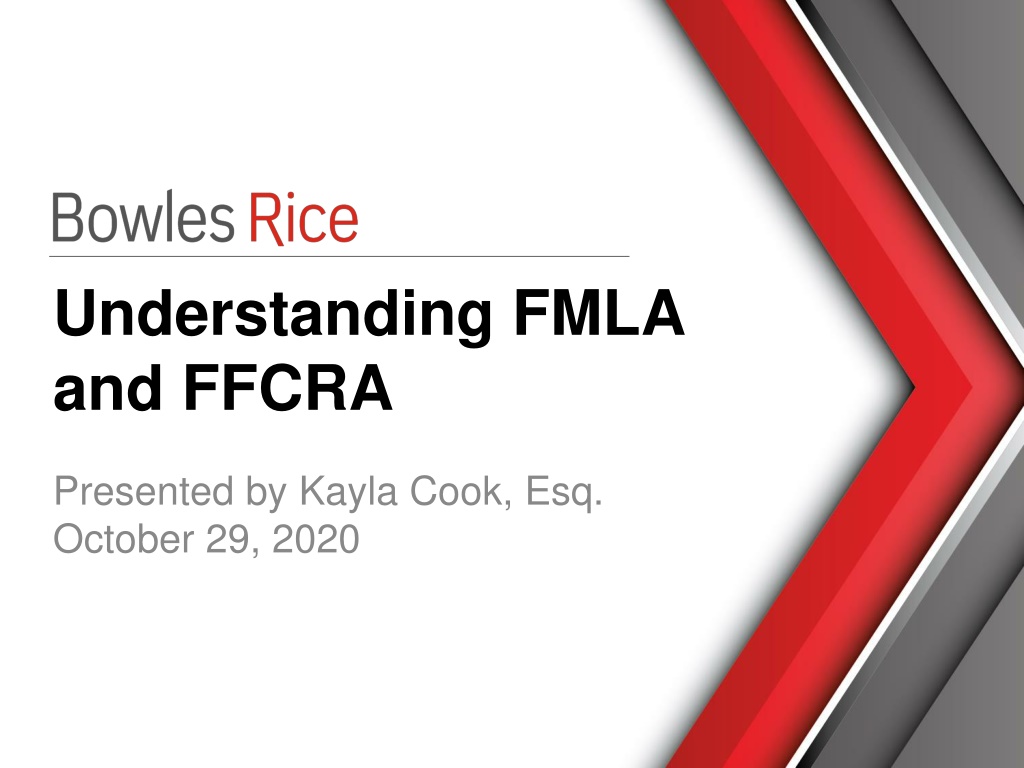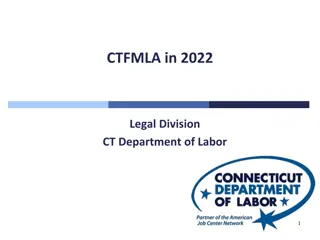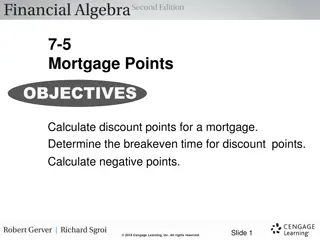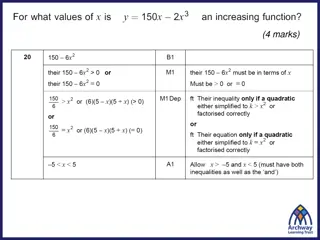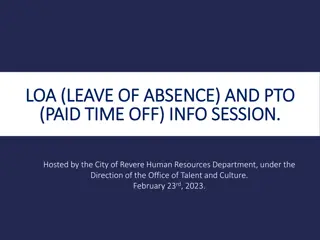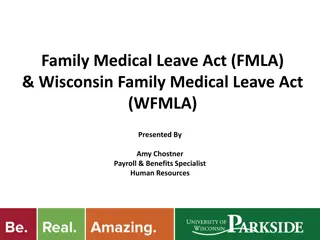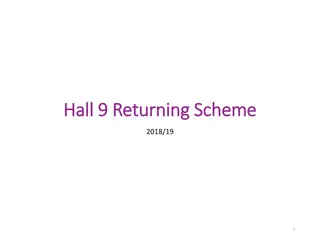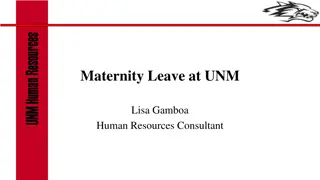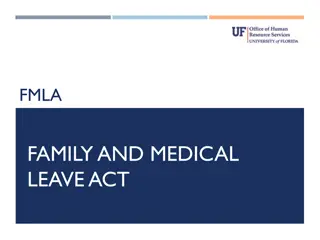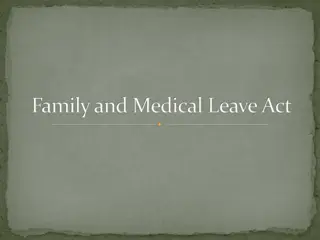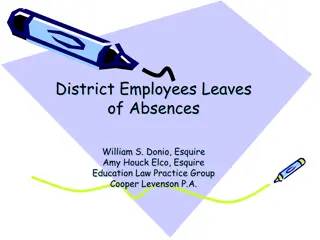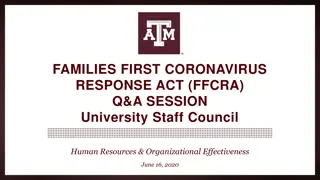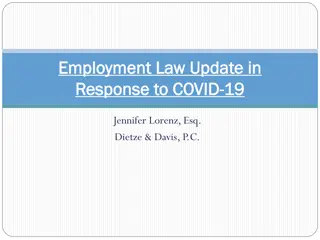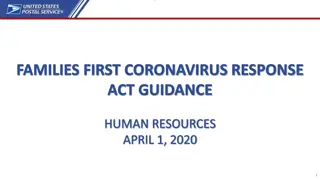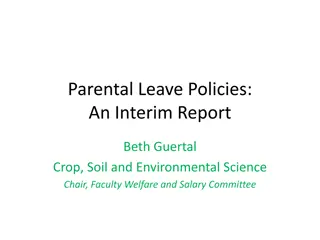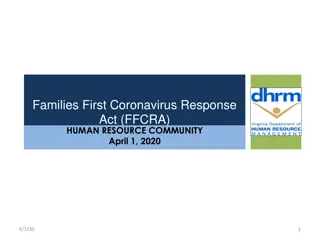Understanding FMLA and FFCRA: Key Points and Information
Comprehensive overview of the Family and Medical Leave Act (FMLA), including employer coverage, employee eligibility, leave entitlement, and key considerations. Presented in a general context by Kayla Cook, Esq., highlighting the importance of seeking legal advice for specific situations due to the evolving nature of the law.
Download Presentation

Please find below an Image/Link to download the presentation.
The content on the website is provided AS IS for your information and personal use only. It may not be sold, licensed, or shared on other websites without obtaining consent from the author. Download presentation by click this link. If you encounter any issues during the download, it is possible that the publisher has removed the file from their server.
E N D
Presentation Transcript
Understanding FMLA and FFCRA Presented by Kayla Cook, Esq. October 29, 2020
A Word About This Presentation I will speak in general terms today. The specific facts of each situation can make a difference in the legal principles that apply This presentation must not be treated as legal advice about any specific situation Due to the rapidly changing nature of the law, information in this presentation may become outdated When in doubt, don t act or rely upon the information contained in this presentation without seeking legal advice
Family and Medical Leave Act (FMLA) Federal Law Enacted in 1993 Administered by the Wage and Hour Division of the United Stated Department of Labor Requires covered employers to provide employees with job-protected and unpaid leave for qualified medical and family reasons.
Employer Coverage Under FMLA The State or a political subdivision of the State ALL public agencies are covered by FMLA regardless of the number of employees Private employers with 50 or more employees for 20+ weeks in a year.
Employee Eligibility Under FMLA To be eligible under FMLA an employee must: Have been employed for at least 12 months, AND Need not be 12 consecutive months Have been employed for at least 1,250 hours during the 12-month period immediately preceding the beginning of the leave, AND Only hours WORKED (does not include paid/unpaid leave) Works at a location where at least 50 employees are employed by the employer (e.g., the State or political subdivision)
Leave Entitlement Under FMLA 12 weeks of unpaid leave during any 12- month period The WORKWEEK is the basis for an employee s leave entitlement, and is not phrased in terms of a particular number of days or hours of leave. 26 weeks of unpaid leave to care for a covered service member in a single 12-month period
Leave Entitlement Under FMLA (continued .) Spouses employed by the same employer may be limited to a combined total of 12 workweeks of family leave for the following reasons: Birth and care of a child; For the placement of a child for adoption or for foster care, and to care for the newly-placed child; and To care for an employee s parent who has a serious health condition
Qualifying Events Under FMLA 1. Birth and care of employee s newborn child 2. Placement of a child with employee for adoption or foster care 3. Care for an immediate family member with a serious health condition 4. Employee is unable to work because of his or her own serious health condition 5. Qualifying exigencies arising out of an immediate family member being on active duty 6. Care for an eligible military member who suffered a serious injury/illness while on active duty for which they are undergoing medical treatment
Serious Health Condition under FMLA Defined as: An illness, injury, impairment, or physical or mental condition that involves: A) any period of incapacity or treatment connected with inpatient care (i.e., an overnight stay) in a hospital, hospice, or residential medical care facility; B) a period of incapacity requiring absence of more than 3 consecutive full calendar days from work, school, or other regular daily activities, and any subsequent treatment or period of incapacity relating to the same condition, that also involves: 1) treatment two or more times, within 30 days of the first day of incapacity, unless extenuating circumstances exists; or 2) treatment by a health care provider on at least one occasion, which results in a regimen of continuing treatment under the supervision of a health care provider.
Serious Health Condition under FMLA (continued ) C) any period of incapacity due to pregnancy, or for prenatal care; D) any period of incapacity (or treatment therefore) due to a chronic serious health condition. Must visit a health care provider at least 2 times per year to qualify. E) a period of incapacity that is permanent or long-term due to a condition for which treatment may not be effective F) any absence(s) to receive multiple treatments (including recovery) by, or on referral by, a health care provider for a condition that likely would result in incapacity for more than 3 consecutive days if left untreated.
Intermittent Leave Under FMLA May be taken when medically necessary for planned and/or unanticipated medical treatment or for recovery from treatment of or recovery from a serious health condition. Must be scheduled so as not to unduly disrupt the employer s operations, subject to the approval of the employee s health care provider.
Notice By Employee When foreseeable: 30-day advance notice When unforeseeable: As soon as practicable When intermittent: In compliance with the employer s call-in procedures
Notice (continued) Employee needs to provide sufficient information for the employer to understand that the leave is for FMLA qualifying reasons. Reason for leave Nature of injury, impairment, or physical/mental impairment that necessitates leave Anticipated duration of leave An employee is not required to mention FMLA when requesting leave, but is required to explain why leave is needed.
Certification If an employee submits a complete certification signed by a health care provider, the employer may not request additional information from the health care provider. An employer can contact health care provider for clarification and authentication. Contact must not be made by a direct supervisor Employers may send summaries of employee s intermittent absences to health care provider to confirm the absences are consistent with the condition.
Medical Opinions SECOND OPINION: An employer at its own expense can require the employee to obtain a second medical opinion Employer chooses provider Employer pays Employer cannot contract with medical provider THIRD OPINION: If first and second opinions differ Employer and Employee both approve provider Employer pays Third opinion is BINDING
Maintenance of Benefits Under FMLA Employer required to maintain benefits as if employee had continued to work. Benefits STOP if employee notifies employer of intent not to return at end of leave, or if employee fails to return after leave Employer may recover premiums paid to maintain health insurance coverage and other benefits for an employee who fails to return from FMLA leave.
Job Restoration Under FMLA Employee is entitled to be retuned to the same position OR an equivalent position with equivalent benefits and pay.
No right to reinstatement if employee is unable to perform an essential function of the position.
Comparing FMLA to the WEST VIRGINIA PARENTAL LEAVE ACT
West Virginia Parental Leave Act State Law Effective October 1, 2010 Administrated by West Virginia Department of Labor The Legislature hereby finds that there is a growing crisis in this country and state affecting the stability of our families, that the family unit is being torn apart due to the need for families to have two income producing parents. In order to address this situation and to provide for the love, nurturing and education of our children, the Legislature hereby enacts The Parental Leave Act. - W. Va. Code 21-5D-1
Employer Coverage Under PLA An Employer includes any department, division, board, bureau, agency, commission, or other unit of state government and any county board of education in the state. 12-5D-2(d)
Employee Eligibility Under PLA Any individual, hired for permanent employment, who has worked for at least 12 consecutive weeks 12-5D-2(c)(1)
Leave Entitlement Under PLA 21-5D-4 (a) 12 weeks of unpaid leave, following the exhaustion of all his or her annual and personal leave, during any 12-month period.
Intermittent Leave Under PLA Leave may be taken on a part-time basis and on a part-time leave schedule provided such leave does not exceed 12 consecutive months and does not unduly disrupt the employer s operations.
Qualifying Events Under PLA Birth of employee s child Placement of child with employee for adoption To care for employee s child, spouse, parent, or dependent who has a serious heath condition DOES NOT INCLUDE THE SERIOUS HEALTH CONDITION OF EMPLOYEE
Serious Health Condition Under PLA A physical or mental illness, injury, or impairment that involves: Inpatient care in a hospital, hospice or residential health care facility Continuing treatment, health care or continuing supervision by a health care provider.
Employees can request leave for Under FMLA Under PLA Son/Daughter- biological, adopted, or foster child; a stepchild; a legal ward; or a child of a person standing in loco parentis who is: (1) under 18, or (2) 18 or older and incapable of self-care because of disability. Son/Daughter- an individual who is a biological, adopted or foster child, a stepchild, or a legal ward, and is (1) under 18; or (2) 18 years or older and incapable of self-care because of mental or physical disability
Employees can request leave for Under FMLA Under PLA Spouse- Husband or wife as defined or recognized in the state where the individual was married, and includes individuals in same-sex and common law marriage. Spouse- Any person legally married to an employee covered by PLA.
Employees can request leave for Under FMLA Under PLA Parent- a biological parent or an individual who stands or stood in loco parentis to an employee when the employee was a son or daughter. Parent- a biological, foster or adoptive parent, a stepparent or a legal guardian.
Employees can request leave for Under FMLA Under PLA Dependent- NO SUCH PROVISION Dependent- Any person who is living with or dependent on the income of any employee, whether related by blood or not.
Employees can request leave for Under FMLA Under PLA Employee- An individual who meets the eligibility criteria. Employee- NOT COVERED UNDER PLA
Notice Under PLA If foreseeable: 2 weeks written notice If an employee requests family leave to care for a family member with a serious health condition, the employer may require the employee to provide certification by a health care provider. Certification is sufficient if it contains the following: 1. A statement that the child, spouse, parent, or dependent has a serious health condition 2. The date the serious health condition commenced and its probable duration 3. The medical facts regarding the serious health condition
Maintenance of Benefits Under PLA Employee is eligible to continue participation in the group health insurance plan if the employee pays the employer 100% of the premium costs. Seniority: 21-5D-7(a): Nothing in this section entitles any returning employee to the accrual of any seniority or employment benefits during any period of family leave.
Job Restoration Under PLA The employee shall be returned to the position held immediately prior to the leave.
Employees eligible for leave under both FMLA and PLA are entitled to the greatest benefit or most generous rights provided under the different parts of each. The determination of the most generous benefit will be at the employee s discretion and the employee shall notify the employer of the benefit/right he or she wishes to use. If the paid and/or unpaid leave qualifies under both FMLA and PLA, the leave entitlement under each shall exhaust concurrently.
FAMILIES FIRST CORONAVIRUS RESPONSE ACT
Families First Coronavirus Response Act (FFCRA) Federal Law Effective April 1, 2020 through December 31, 2020 Administered by the Wage and Hour Division of the United Stated Department of Labor Requires certain employers to provide employees with paid sick leave or expanded family and medical leave for specified reasons related to COVID-19.
Covered Employers Under FFCRA FFCRA applies to all private employers with fewer than 500 employees and government employers with more than one employee. All public school districts are subject to the requirements of FFCRA.
Eligible Employees Under FFCRA All employees of covered employers are eligible for two weeks of paid sick time Employees employed for at least 30 days are eligible for up to an additional 10 weeks of paid family leave to care for a child under certain circumstances related to COVID-19.
Qualifying Events Under FFCRA Employee is unable to work OR unable to telework due to a need for leave because the employee: 1) Is subject to a Federal, State, or local quarantine or isolation order; 2) Has been advised by a health care provider to self-quarantine; 3) Is experiencing COVID-19 symptoms and is seeking a medical diagnosis; 4) Is caring for an individual subject to an order described in (1) or self- quarantine as described in (2); 5) Is caring for a child whose school or place of care is closed (or child care provider is unavailable) for reasons related to COVID-19; or A full-time employee is eligible for up to 12 weeks of leave (2 weeks of paid sick leave followed by 10 weeks of paid expanded FMLA at 2/3 rate) at 40 hours a week A part-time employee is eligible for leave for the number of hours the employee is normally scheduled to work over that period. 6) Is experiencing any other substantially-similar conditions specified by the Secretary of Health and Human Services, in consultation with the Secretaries of Labor and Treasury.
Leave Entitlements Under FFCRA Two weeks (max 80 hours) of paid sick leave at the employee s regular rate of pay where the employee is unable to work because the employee is quarantined, and/or experiencing COVID-19 symptoms and seeking a medical diagnosis Two weeks (max 80 hours) of paid sick leave at two-thirds the employee s regular rate of pay because the employee has bona fide need to care for an individual subject to quarantine, or to care for a child (under 18 years of age) whose school or child care provider is closed
Leave Entitlements Under FFCRA (continued ) Ten weeks of paid expanded family and medical leave at two-thirds the employee s regular rate of pay where an employee, employed for at least 30 calendar days, is unable to work due to bona fide need for leave to care for a child whose school or child care provider is closed.
Calculation of Pay If reason for leave: 1) Is subject to a Federal, State, or local quarantine or isolation order 2) Has been advised by a health care provider to self-quarantine 3) Is experiencing COVID-19 symptoms and is seeking a medical diagnosis; Then pay calculated At the regular rate or applicable minimum wage, whichever is higher, up to $511 per day and $5,110 over a two-week period.
Calculation of Pay If reason for leave: 4) Is caring for an individual subject to an order described in (1) or self- quarantine as described in (2) Then pay calculated At two-thirds (2/3) regular rate or 2/3 the applicable minimum wage, whichever is higher, up to $200 per day and $2,000 over a two- week period. 6) Is experiencing any other substantially-similar conditions specified by the Secretary of Health and Human Services, in consultation with the Secretaries of Labor and Treasury
Calculation of Pay If reason for leave: 5) Is caring for a child whose school or place of care is closed (or child care provider is unavailable) for reasons related to COVID-19 Then pay calculated At two-thirds (2/3) regular rate or 2/3 the applicable minimum wage, whichever is higher, up to $200 per day and $12,000 over a two-week period
Paid sick time under FFCRA does not carryover from one year to the next. Employees are not entitled to reimbursement for unused leave upon termination, resignation, retirement, or other separation from employment. An employee may elect to substitute any accrued vacation leave, personal leave, or medical or sick leave for the first two weeks of partial paid leave under this section.
An employee taking expanded FMLA may take paid sick leave (full rate of pay) or substitute any accrued leave under policy for the first 2 weeks, then for the remaining 10 weeks be paid at 2/3 rate. If chose to take paid sick leave= still capped at $200 per day or $12,000 for the twelve weeks that include both paid sick leave and expanded FMLA. If choose to use accrued leave during first two weeks= entitled to full amount for such leave even if greater than $200 per day.
